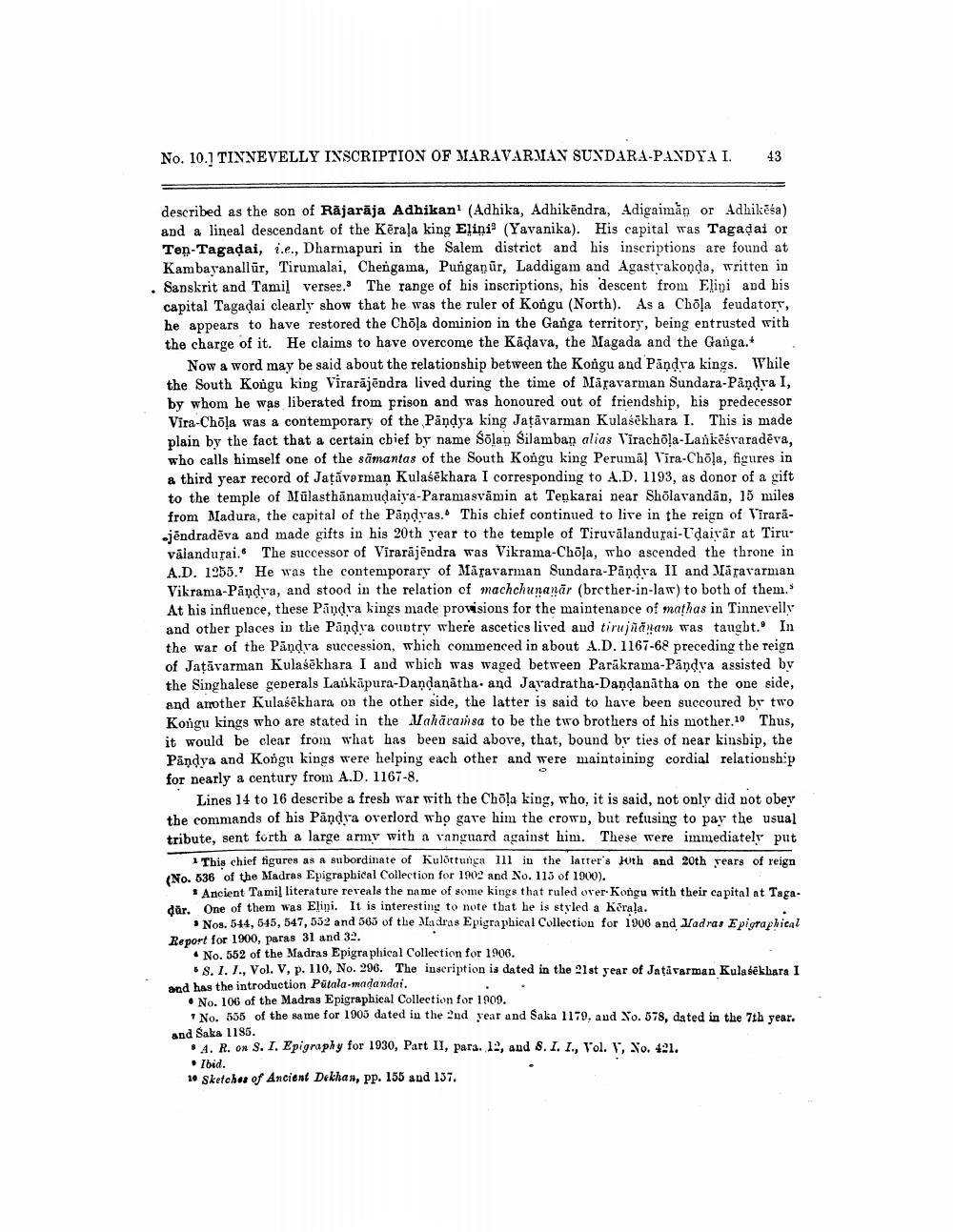________________
No. 10.1 TINNEVELLY INSCRIPTION OF MARAVARMAN SUNDARA-PANDYAL.
43
described as the son of Rājarāja Adhikan' (Adhika, Adhikēndra, Adigaiman or Adhikēša) and a lineal descendant of the Kēraļa king Elini (Yavanika). His capital was Tagadai or Ten-Tagadai, i.e., Dharmapuri in the Salem district and his inscriptions are found at Kambayanallur, Tirumalai, Chengama, Pungaņūr, Laddigam and Agastyakonda, written in Sanskrit and Tamil verses. The range of his inscriptions, his descent from Elini and bis capital Tagadai clearly show that he was the ruler of Kongu (North). As a Chola feudatory, he appears to have restored the Chõļa dominion in the Ganga territory, being entrusted with the charge of it. He claims to have overcome the Kādava, the Magada and the Ganga.
Now a word may be said about the relationship between the Kongu and Pāņdva kings. While the South Kongu king Virarājēndra lived during the time of Märavarman Sundara-Pändra I, by whom he was liberated from prison and was honoured out of friendship, his predecessor Vira-Chola was a contemporary of the Pandya king Jațāvarman Kulasekhara I. This is made plain by the fact that a certain cbief by name Solan Silamban alias Vīrachola-Lankësvaradeva, who calls himself one of the samantas of the South Kongu king Perumal Vira-Chola, figures in a third year record of Jațăvorman Kulasēkhara I corresponding to A.D. 1193, as donor of a gift to the temple of Mülasthanamudaiya-Paramasvāmin at Tenkarai near Shõlavandan, 18 miles from Madura, the capital of the Pāndvas. This chief continued to live in the reign of Virarăjēndradēva and made gifts in his 20th year to the temple of Tiruvālandurai-l'daivār at Tiru vaiandurai. The successor of Virarājēndra was Vikrama-Chola, who ascended the throne in A.D. 1955.7 He was the contemporary of Mayavarman Sundara-Pāņdra II and Jāpavarman Vikrama-Pāņdva, and stood in the relation of machchunanär (brother-in-law) to both of them.” At his influence, these Pandva kings made provisions for the maintenance of mathas in Tinnerelly and other places in the Pandya country where ascetics lived and tirujnanan was taugbt. In the war of the Pāņdva succession, which commenced in about A.D. 1167-68 preceding the reign of Jațăvarman Kulasēkhara I and which was waged between Parākrama-Pāndra assisted by the Singhalese generals Laikāpura-Dandanātha and Javadratha-Dandanātha on the one side, and arrother Kulasēkhara on the other side, the latter is said to have been succoured by two Kongu kings who are stated in the Mahāransa to be the two brothers of his mother.10 Thus, it would be clear from what has been said above, that, bound by ties of near kinship, the Pandya and Kongu kings were helping each other and were maintaining cordial relationship for nearly a century from A.D. 1167-8.
Lines 14 to 16 describe a fresh war with the Chola king, who, it is said, not only did not obey the commands of his Påndva overlord who gave him the crown, but refusing to pay the usual tribute, sent forth a large army with a vanguard against him. These were immediately put
This chief figures as a subordinate of kulörtunga 1ll in the latter's Joth and 20th years of reign No. 536 of the Madras Epigraphical Collection for 1902 and No. 115 of 1900).
Ancient Tamil literature reveals the name of some kings that ruled over Kongu with their capital at Tagadär. One of them was Elini. It is interesting to note that he is styled a Kirala.
Nos. 544, 545, 547, 552 and 565 of the Madras Epigraphical Collection for 1906 and Jadras Epigraphical Report for 1900, paras 31 and 32.
No. 552 of the Madras Epigraphical Collection for 1906.
8.1. ., Vol. V, p. 110, No. 296. The inscription is dated in the 21st year of Jatavarman Kulasekhara I and has the introduction Pütala-madandai.
• No. 106 of the Madras Epigraphical Collection for 1909.
IN 555 of the same for 1905 dated in the 2nd year and Saka 1179, and Xo. 578, dated in the 7th year. and Saka 1185.
A. R. on S. 1. Epigraphy for 1930, Part II, para. 12, and 8.1. I., Vol. V, Xo. 421. . Ibid. 10 Sketches of Ancient Dekhan, pp. 155 and 157.




